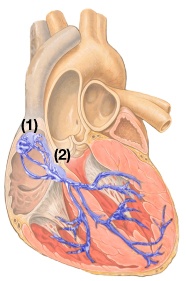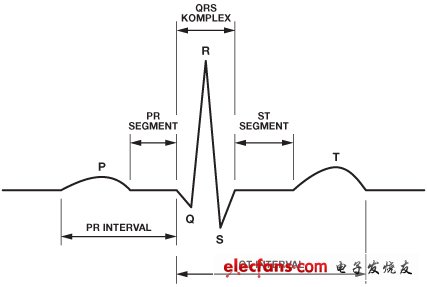When a cardiac patient with a pacemaker implants an electrocardiogram (ECG) test, the cardiologist must be able to detect the presence and effectiveness of the pacemaker. The electrical characteristics (or artifacts) of the pacing signal are composed of small, narrow pulses. Because these artifacts are submerged in noise and large ECG signals, they are difficult to detect. This article will describe the nature of pacing artifacts and introduce a device and method for detecting such artifacts.
The heart, as a biochemical electromechanical system, generates electrical pulses, which are conducted from the sinoatrial node (SA) in the upper right atrium to the AV node (AV). Sinus nodules act as pacemakers for this system (Figure 1).

Figure 1. Myocardium and sinus node (1) and atrioventricular node (2)
This electrical pulse generates a P wave, which can be seen in the ECG screenshot in Figure 2. Electrical signals begin to propagate from the atrioventricular nodules, pass the Purkinje fiber system, and reach the ventricle, causing contraction of the ventricular muscles. This contraction (R wave) allows oxygenated blood to enter and flow through the body from the left ventricle, while allowing hypoxic blood to enter the lungs from the right ventricle.

Figure 2. ECG graphical representation of electrical behavior during myocardial contraction 2
If the electromechanical system of the heart is defective, it may cause many heart problems. For example, when the heart is too slow or not beating, it is bradycardia. For this situation, the typical surgical treatment method is to implant a pacemaker (pulse generator) subcutaneously in the chest of the patient, and direct the endocardial lead to the heart through the vein, as shown in Figure 3.

Figure 3. Location of implantable pacemakers and lead wires for different types of pacemakers
(RA—right atrium, RV—right ventricle, LV—left ventricle)
In another type of arrhythmia called tachycardia, the heart beats too fast. This is a very serious disease that can be treated with an implantable cardiac defibrillator (ICD). Modern ICDs can also treat a variety of bradyarrhythmias.
When the heart becomes larger, heart failure may occur because the conduction path becomes longer, disrupting the timing of ventricular contraction. The result is a positive feedback system that further increases the burden on the heart. Implantable cardiac resynchronization (ICR) devices simultaneously pace two ventricles and (usually) one atrium to retime the ventricles. In fact, these devices will improve cardiac output, thereby restoring the heart to a certain extent. Cardiac resynchronization therapy (CRT) device is a system including ICD.
The CRT device can be seen in the perspective image in Figure 4 (a). The doctor uses this image to place the lead. For non-professionals, this image is difficult to interpret. You can see the light outline of the heart-this is a static view of the beating heart. The pacemaker is located on the right atrium with the apex of the heart pointing to the lower right. In this typical lead placement example, the black arrow points to the right atrium lead. The dotted black arrow points to the right ventricular lead. The lead marked with a red arrow can only be seen partly. This is the left ventricular lead (the red arrow points to the electrode tip). Figure 4 (b) shows a typical lead placement perspective image of a dual-chamber pacemaker. The right atrium lead is pointing upwards and placed in the right atrium. The right ventricular lead is located at the top of the right ventricle.

Figure 4. Perspective image of pacemaker lead placement 3
(A). Single-chamber pacemaker; (b). Dual-chamber pacemaker
Kitchen ventilation isn`t a luxury; it`s a necessity. Glass Range Hoods are engineered knowing that all kitchens should have proper ventilation. With this philosophy in mind, xunda endeavors to deliver the most affordable designer Range Hoods available. We bring a passion for engineering the best possible products for homeowners wishing to own the very best, no matter the price. xunda range hoods are constructed using the most stringent manufacturing guidelines and over-deliver on good old-fashioned functionality and features. It`s our belief that proper ventilation is crucial to your kitchen design and to your dining experience.
Glass Range Hoods
Glass Range Hoods,Kitchen Vent Hood,Stainless Range Hood,Black Range Hood
xunda science&technology group co.ltd , https://www.gasstove.be